Current Research
The Gast Group is currently performing research in several areas described below.
| Protease Adsorption, Diffusion and Reaction on Immbolized Substrate Surfaces
Investigator: Shaunak Roy (Co-advisor: Prof. Channing Robertson)
|
|
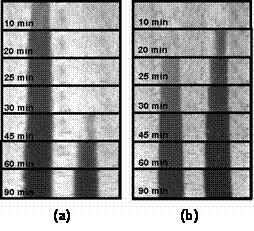
|
We study the interaction of a subtilisin protease enzyme with a model protein (bovine serum albumin (BSA)) coated surface
to understand the kinetics of stain removal at fabric surfaces for detergent enzyme applications.
We measure adsorbed enzyme concentrations and substrate cleavage rates in situ,
and compare the surface reactivities with those in solution using a combination of surface plasmon resonance (SPR)
and surface plasmon enhanced fluorescence (SPEF) techniques in a microfluidic device.
By varying the ionic strength of the system and studying several single point mutations of subtilisin,
we find that the adsorption behavior and surface reactivity of the enzyme are strongly influenced by electrostatic interactions with the charged BSA surface.
In our more recent work, we address the lateral surface mobility of the enzyme.
Microfluidic patterning allows us to decorate a region of the bovine serum albumin substrate surface with a subtilisin protease in the absence of physical barriers.
Any spreading of the enzyme from this initial region indicates surface diffusion, while removal of the substrate provides a measure of reactivity.
The reaction/diffusion behavior of a wildtype and mutant subtilisin enzyme interacting
with a substrate surface at conditions of low (a) and high (b) ionic strength. In either case the wildtype enzyme is flowed down the left lane and the mutant down the right lane.
Here, it is clear that the wildtype both reacts and diffuses more rapidly than the mutant enzyme at low ionic strength.
At high ionic strength however, the trend is reversed, indicating a significant contribution of electrostatic interactions on the reactivity of enzymes at surfaces.
|
|
Poly-ethylene-glycol
Linked Chains of Magnetic Colloidal Particles: Mechanics
and Applications
Investigator: Lisa
Biswal
|
|
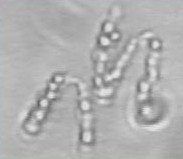
|
Paramagnetic particles have the unique ability to aggregate into
reversible linear chains under the influence of an external
magnetic field. We create permanently linked chains by crosslinking
1mm particles using streptavidin-biotin chemistry. Streptavidin
is a tetrameric protein with a high affinity for the molecule
biotin. Streptavidin-coated microspheres are placed in a
flow cell and a magnetic field is applied, causing the particles
to form chains. Then a solution of polymeric linkers of
bis-biotin-polyethylene glycol molecules is added in the
presence of the field. These linked chains remain responsive
to the magnetic field, allowing their orientation and flexibility
to be controlled by directing the field and changing the
field strength.
Cross-linked paramagnetic particles form
flexible chains which can move and bend freely. In the presence
of a magnetic field, the chains stiffen in the direction
of the magnetic field.
|
Polymer Architecture and the Effect on Physical Properties
Investigator: Paulina Achurra |
|
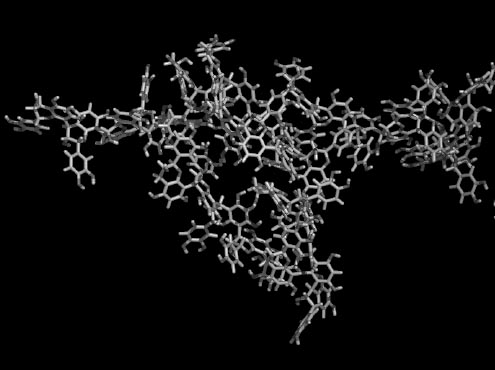
|
The study of polymer architecture and the effect on their physical properties has long been an interest in our group.
In recent years much effort has been made to understand how macromolecular architecture affects the physical properties of polymers.
It has been shown that polymer architecture greatly impacts properties such as size, solubility, cloud point, crystallinity, among others.
Additionally, it has also been shown interactions with other molecules, such as proteins, or among themselves, is also greatly influenced by polymer topology.
We use microfluidics to study the effect of polymer architecture on protein-polymer interactions and polymer induced protein-protein interactions.
Molecular dynamics (MD) simulation of 8 proanthocyanidin (PA) pentamers in water.
Molecular aggregration is observed based on 2D stacking model interactions.
PAs are a subset of tannins found in food and wines. Interactions between PAs and salivary proteins
influence the physiological detection of taste and flavor.
|
Protein Structure and Assembly in Model Biological Membranes
Investigator: Margaret Horton |
|
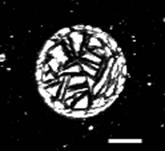
|
This works aims to achieve a better understanding of supramembraneous
and intramembraneous protein assembly in model biological membranes.
Giant unilamellar vesicles (GUVs) provide a model membrane system for
the fundamental study of protein-lipid association and cytomimetic
processes.
The picture on the left shows two-dimensional
streptavidin crystals on the surface of a giant unilamellar
vesicle (GUV) containing biotinylated lipids. Streptavidin
crystals are dark and fluorescent regions are non-crystallizable
FITC-avidin. Scale bar is 10 microns.
|
|
Magnetorheological Fluids in Microgravity
Investigator: Kerry Bentley
|
|
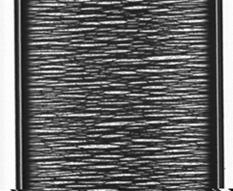
|
The dynamics of the formation of magnetic microstructures have recently been investigated in the International Space Station (ISS) through a collaboration with NASA,
and these experiments are planned as far as the year 2007.
The microgravity environment of the ISS magnifies the delicate balance between surface tension effects and magnetic field effects in magnetorheological fluids,
allowing more precise investigation of the dynamics than possible in gravity.
The dynamics resulting from external magnetic fields produce useful effects such as a tunable viscosity,
which is currently being utilized in devices such as mechanical dampers.
The structures formed become increasingly complex when the external magnetic field is pulsed,
which results in steady structures that balance diffusion, surface tension, and magnetic effects.
This is a sample of a magnetorheological fluid in a 1 mm vial with an external magnetic field.
The lateral stripes are evidence of the colloidal particles that have formed a cross-linked network in the direction of the imposed field.
|
|